Your furnace’s control board is essential for regulating fan and burner operations. However, when it starts to malfunction, your entire system’s performance could suffer.
Spotting a faulty control board can be tricky. However, being able to recognize its tell-tale signs allow you to take preventative measures before your furnace reaches an irreparable state.
If you think your furnace control board might be on the fritz, this article is here to help. We’ll give you pointers on how to identify a bad furnace control board.
Additionally, we’ll walk you through the steps you should take to ensure your HVAC system runs smoothly again.
What is a Furnace Control Board?
A control board is a circuit board that consists of several resistors and relays. These components control the speed, temperature, and other functions of your furnace’s fan and burners.
In most cases, you can find this control board located inside the control panel of your furnace. The control panel itself sits at the bottom of the furnace, right behind the front door.
Types of Furnace Control Boards
There are commonly two types of furnace control boards:
- Simple Ignition Furnace Control Boards
- Integrated Furnace Control Boards
Let’s take a look at each type to better understand their functions.
Simple Ignition Furnace Control Boards
This type of control board is found in older furnaces and is used to control the flame sensor, igniter, and gas valve.
It’s less efficient than an integrated furnace control board. However, it is much cheaper and easier to install.
Simple ignition control boards are installed alongside a fan control board.
Integrated Furnace Control Boards
Modern furnaces are equipped with an integrated furnace control board. You don’t need to install a separate fan control board alongside this model.
It controls every aspect of your furnace’s fan and ignition operations. It’s the most convenient and efficient furnace control type available.
What Causes Furnace Control Board Failure?
Furnace control boards are exposed to extreme temperatures and other conditions that can cause them to malfunction.
Here are some of the most common causes of control board failure:
- A power surge from outages or lightning strikes
- Cold weather causes the control board’s components to freeze up
- Age, wear and tear
- Improper installation
Signs of a Bad Furnace Control Board
Here are some of the common signs to look out for if you suspect your control board has gone bad:
- Your furnace won’t start up at all or it takes several tries before it starts.
- The burners keep turning on and off or they won’t shut off completely.
- The fan is continuously running even when your furnace isn’t heating the home.
- Your control panel is giving off a burning smell, indicating an electrical malfunction.
How to Tell if Your Furnace’s Control Board is Bad?
Control boards are prone to malfunctions that can disrupt the furnace’s operations. However, as they are often out of sight, it can be tricky to know when something is wrong.
Follow these steps to find out if your control board is bad:
Step 1: Gather Tools
You need the following tools to test your control board for dysfunctions:
- A voltage meter (to check your control board’s power output and supply)
- A screwdriver (to remove access panels)
- A roll of electrical tape (to hold the furnace door open)
Step 2: Remove Access Panels
Furnaces normally have two panels: one that houses the furnace components and another that holds the control board.
The location of these two panels will vary between furnace models. Check your furnace manual to find out where your unit’s access panels are located.
Once you’ve located it, use your screwdriver to loosen the screws holding the access panel. Place the screws and panel in a safe and dry place.
Step 3: Evaluate the Control Board Indicator Light
Most control boards have an indicator light that can tell you if something is wrong.
If the control board’s diagnostic light is blinking, it means your control board has detected an issue with its circuit.
Most manuals have error codes listed for homeowners to refer to during emergencies.
Check your furnace manual to see what error your furnace’s circuit board diagnostic light is indicating.
Step 4: Test Control Board Power Supply
With your voltage meter, test the control board’s power supply to see if it’s getting enough electricity.
Find the shared wire connecting your transformer to your control board. It should have a black exterior and a 120VAC Hot label. Use your voltage meter to check if there is power flowing in the line.
If the readings are too low, you might have to replace the control board.
However, if its readings match with those indicated in the control board manual, then it is likely functioning correctly.
Step 5: Test Thermostat Terminals
When troubleshooting a furnace, testing the thermostat terminals on the control board is key to determining whether they need to be replaced.
First, power must be applied to the control board and ensure that the control board indicator light blinks.
Next, use a wire to connect and test each terminal—R and G, R and W, and R and Y—by turning the furnace on and off between tests.
If Blower Motor comes on at R and G, Heating at R and W, and Cooling at R and Y, then the control board can likely be saved.
This simple but thorough process is an important step in ensuring that your furnace is operating correctly.
Step 6: Test Control Board Output Power
Finally, you can use a control board to test the control board output power.
Turn the furnace off and check each control terminal of your control board. Start with either Hot or Ground then move on to Cooling, Heat, Fan, and Limit Switches.
If your voltage meter readings show no power at any of these control terminals, then you should replace your control board.
Meanwhile, if all readings are normal and the control terminal lights up when turned on, the control board is functioning correctly.
What to Do When a Furnace Control Board Goes Bad?
If your control board has gone bad, you have two options: replace it or repair it.
Replacing the control board is the simpler and more cost-effective choice since control boards are relatively inexpensive and easy to install. However, if your control board is still under warranty, you may be able to have it repaired for free.
Either way, it’s important to contact an HVAC technician if you think your control board has gone bad. They can help you troubleshoot the problem and determine the best course of action for getting your furnace back up and running.
How to Install a New Furnace Control Board?
If you’re confident enough in your DIY skills to install a new furnace control board, the following steps can help you stay on track:
Step 1: Snap a Photo of the Old Control Board
Take a picture of the control board and wiring setup, so you can refer to it during installation.
Step 2: Cut Power to the Furnace
To ensure your safety, make sure to cut power from the furnace before removing the control board or doing any repairs.
Step 3: Remove Connections
Unscrew the control board cover and disconnect all wires from the control board terminals.
Step 4: Remove the Old Control Board
Remove the old control board by unscrewing it from its bracket.
Step 5: Install New Control Board
Before installing the new board, ensure that it’s compatible with your furnace. Then, attach it to the bracket and secure it with screws.
Step 6: Connect Wires
Connect the control board wires according to the wiring setup diagram you took for reference.
Step 7: Test Control Board
Turn on the power to your furnace and test that all connections are working properly before replacing the control board covers.
REMINDER: Installing a control board is an easy job, but if you’re not familiar with furnace maintenance, it’s always best to call in a professional HVAC technician. Doing so can help keep your furnace working its best and ensure that the control board is installed correctly.
How Long Should Your Furnace’s Control Board Last?
Furnace control boards usually last between five and fifteen years, depending on how frequently the furnace is used.
However, their lifespan can be shortened if they are exposed to extreme temperatures or high levels of dust and debris. It’s important to keep your control board clean and properly maintained to extend its life expectancy.
If you suspect that your control board is failing, contact a professional HVAC technician right away so they can inspect it and replace it if needed.
Taking care of your control board is key to ensuring that your furnace runs smoothly and efficiently for years to come.
Professional Furnace Control Board Testing and Replacement
Troubleshooting and replacing control boards can be confusing, so it is best for an experienced HVAC technician to handle them. Their expertise can help ensure the job is performed accurately and efficiently.
A technician can assess your control board’s performance, determine the cause of malfunction or failure, and replace it if needed. They can also make sure that the control board is properly wired for optimal performance and energy efficiency.
We Can Help with Your HVAC Issues
BelRed Energy Solutions can help homeowners troubleshoot furnace control board issues quickly and efficiently.
Our HVAC technicians are NATE-certified, meaning they have the expertise necessary to hunt down control board issues and resolve them for good.
We use cutting-edge diagnostic equipment and professional tools to ensure that your control board is working properly and your furnace is running at its best.
If you’re having control board issues, don’t hesitate to contact us for a free quote today!
Contact (855) 345-6161
Our team will be more than happy to help you get your furnace up and running again.







